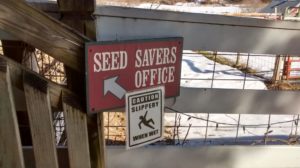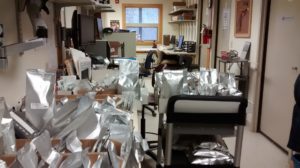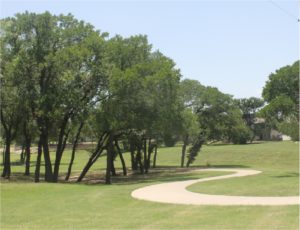The Art of Seed Saving: Riley ’19 at Seed Savers Exchange in Decorah, Iowa
Jun 12, 2017My second co-op has been spent at an organization by the name of Seed Savers Exchange in Decorah, Iowa. Seed Savers Exchange is an organization dedicated to conserving and promoting America’s culturally diverse but endangered garden and food crop heritage for future generations, and they carry this dedication out by collecting, growing, and sharing heirloom seeds and plants. To find out more about the organiz ation, follow this link: https://www.seedsavers.org/.
ation, follow this link: https://www.seedsavers.org/.
The length of my intern position was concentrated in the preservation department of the organization, where I worked in four subsections: seed processing, evaluation, seed history, and the seed lab. Each subsection presented me with unique responsibilities that gave me the opportunity to explore the entirety of Seed Savers Exchange in fragments and as a whole.
My internship began in seed processing, where I was responsible for cleaning and preparing seeds for germination testing. Because my position took place in the winter, I caught the tail end of the crops that needed to be prepared from the 2016 “grow-outs” for germination testing; grow-outs were crops selected for growing at Heritage Farm, the farm on the Seed Savers Exchange campus, from the thirty-thousand accession seed collection for various purposes such as increasing inventory, testing purity, and identifying possible duplicates within the collection which could later be deaccessioned and removed from the collection. After the selected crops were grown, they were harvested for seeds. The harvested seeds were then sent to the area in which I worked for the first week and processed. Processing involved examining the seeds for any obvious impurities that could be removed, singulating the seeds with high-pressure air, running the seeds through a column blower to select for the more viable seeds, sorting through them once more with tweezers, and finally placing them in a bag and marking them ready for testing. The purity of the seeds was maintained by never having more than one bag of seed open at a single time. This part of my internship involved the most manual labor, which was nice as it kept me alert and awake.
Following seed processing, I was assigned a position with the evaluation team. The evaluation team of Seed Savers Exchange is accountable for a diverse set of responsibilities, ranging from gathering data from crop taste tests to evaluating the purity of seed inventory. My tasks included editing and renaming images according to the organization protocol, entering taste test data and comments into Excel spreadsheets, and recording characteristics of seeds. While I did not find this position to be the most interesting, it was still engaging in that I was getting to experience yet another branch of the organization at its deepest level.
I was later  placed in the seed history subsection of preservation after two weeks with the evaluation team. My work within this subsection started off slow, but it came to be my favorite subsection to work in out of my internship experience as a whole. The seed history team is responsible for tracking down and researching each variety of seed within the collection; this research is performed by leafing through seed catalogs, some predating 1850, in the organization’s library for varieties by the same or similar name, utilizing online databases of catalogs and countless other online resources, and contacting individuals who were responsible for donating the seeds to the collection. I became completely captivated through researching the accessions, and I constantly found myself pleasantly consumed by the research required for verifying the credibility of each accession I was assigned to. My experience within this section had a strong impact on my plans for future work endeavors.
placed in the seed history subsection of preservation after two weeks with the evaluation team. My work within this subsection started off slow, but it came to be my favorite subsection to work in out of my internship experience as a whole. The seed history team is responsible for tracking down and researching each variety of seed within the collection; this research is performed by leafing through seed catalogs, some predating 1850, in the organization’s library for varieties by the same or similar name, utilizing online databases of catalogs and countless other online resources, and contacting individuals who were responsible for donating the seeds to the collection. I became completely captivated through researching the accessions, and I constantly found myself pleasantly consumed by the research required for verifying the credibility of each accession I was assigned to. My experience within this section had a strong impact on my plans for future work endeavors.
I am currently working in the seed lab, where I am performing germ tests and packaging seeds for storage and distribution. The germ tests are extremely meticulous, which allows me to stay involved and attentive to the details required for an unhindered test. Packaging, a more physically laborious task, keeps me on my feet. I have packaged for a few different destinations, w ith one being the global seed vault in Svalbard, Norway. For a little background information, the seed vault in Svalbard is located deep inside a mountain on a remote island where conditions are ideal for preserving seeds. For more on Svalbard, visit this link: https://www.croptrust.org/our-work/svalbard-global-seed-vault/. I find it extremely satisfying to know that I am handling seeds that may be used far into the future to maintain the global food gene bank and preserve resources.
ith one being the global seed vault in Svalbard, Norway. For a little background information, the seed vault in Svalbard is located deep inside a mountain on a remote island where conditions are ideal for preserving seeds. For more on Svalbard, visit this link: https://www.croptrust.org/our-work/svalbard-global-seed-vault/. I find it extremely satisfying to know that I am handling seeds that may be used far into the future to maintain the global food gene bank and preserve resources.
This experience has been greatly satisfying and worth the winter weather that has struck Decorah during my time here. I have been given the privilege of residing in a farm house five minutes walking-distance from the main campus of the organization, and the land surrounding Seed Savers Exchange is absolutely beautiful. While I do not feel like I have fully experienced Decorah, I am going to do my best to explore what I can with the little time I have left.
You May All Go To Hell, and I Will Go To Texas: Riley ’19 at RAND Corporation and City Parks Alliance in Dallas, Texas
Jul 11, 2016For my first  co-op, I am back in Texas, my home state, working under the Research and Development (RAND) Corporation and the City Parks Alliance (CPA). The RAND Corporation exists to “help policymakers make decisions that are based on the best available information” with results “fueled by the best data, the strongest methods, and the brightest minds”. The CPA is an organization whose primary mission is to “engage, educate, and nurture a broad-based constituency to support the creation, revitalization, and sustainability of parks and green space that contribute to dynamic cities”. For further information regarding RAND and CPA, feel free to visit these websites: https://www.rand.org/ https://www.cityparksalliance.org/
co-op, I am back in Texas, my home state, working under the Research and Development (RAND) Corporation and the City Parks Alliance (CPA). The RAND Corporation exists to “help policymakers make decisions that are based on the best available information” with results “fueled by the best data, the strongest methods, and the brightest minds”. The CPA is an organization whose primary mission is to “engage, educate, and nurture a broad-based constituency to support the creation, revitalization, and sustainability of parks and green space that contribute to dynamic cities”. For further information regarding RAND and CPA, feel free to visit these websites: https://www.rand.org/ https://www.cityparksalliance.org/
RAND and CPA are in partnership in completing the National Study of Neighborhood Parks. The National Study of Neighborhood Parks is a four-year long study funded by the National Heart, Lung, and Blood Institute, aiming to better understand how local neighborhood parks contribute to physical activity and assess park management practices and programming. Data contributing to this study is being collected in randomly selected parks in twenty-seven cities across the country, with Dallas being one of these cities. To learn more about this study, visit this page: https://www.cityparksalliance.org/why-urban-parks-matter/national-study-of-neighborhood-parks
As a data collector in this study, I was flown out to Los Angeles, California in the middle of March to participate in a three-day training program. While in Los Angeles, we were given more information on the National Study of Neighborhood Parks and trained in SOPARC, a system for observing play and recreation in communities. This system consists of assessing the activity level of people in parks, which ranges from sedentary to moderate to vigorous depending on the type of activity the people are engaged in, along with the age and race/ethnicity of the park goers. To practice SOPARC, we were taken out to two neighborhood parks in Los Angeles with several other people chosen to collect data from around the country. To collect the data, we were provided tablets installed with an Open Data Kit where we record our observations, consisting of pictures of the park, number of users, characteristics of the park, and the atmosphere of the park; at the end of each day, we are expected to upload the data to our supervisors. In addition to collecting data, we are expected to administer surveys to park users as well. Our training days ended around five in the afternoon, giving us time to explore Los Angeles in our free time. With my free time, I took Uber to Venice Beach and Sunset Boulevard to visit Amoeba Records, the largest record store in the country.
Performing the data collection in Dallas has been much different than what was experienced in Los Angeles. The two parks in Los Angeles were very busy; there were many people skateboarding, running, walking their dogs, and people doing various other activities. Counts of park goers in these parks were in the hundreds. Because there were so many people to account for in these parks, both my partner, Danielle, and I were nervous as to how accurately we could count the people in the parks in Dallas. In the three parks that we have completed data collection in so far, the highest number of park users we have counted in a day has been ten; because of these low counts, we have not been able to administer many surveys. Of the surveys we have given out, the majority have been in Spanish, which creates a bit of a language barrier, but it has also allowed me to practice Spanish, the language I am studying at Antioch. While the small counts have been a relief to our worries, it is dismaying to witness the lack of use of urban parks in the Dallas area due to the fact that the parks are very well-kept. We have wondered why the parks do not get as much use as those in Los Angeles, and we believe that the bigger yards in Texas may be a contributing factor. If the parks are not being used, I believe there is no point in maintaining them, seeing as there are other areas of life in Dallas that need funding as well.
Because Danielle and I have a week off between each data collection week consisting of four six-hour days, I have also taken a job as a checker at a grocery store called Tom Thumb. While this job is fun, it is also very stressful. There are many people that expect very fast service, and if we do not get them out of the door as fast as they want us to, they can get a bit upset! Fortunately, I am getting to know a lot of the regular customers, and it is nice to see familiar faces when checking people’s groceries. I have been a little stressed out as well because my pay has been delayed from Tom Thumb for three weeks. I am hoping to get it this week because I am trying to pay for tickets to see The Cure on Sunday at the American Airlines Center in Dallas!
All in all, it is nice to be back in Texas. As the great Davy Crockett once said: “You may all go to Hell, and I will go to Texas.”



